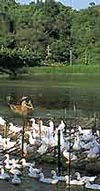 |
Popular
Places |
An interesting sight in Tai Po Kau is Hong Kong's oldest reserve,
which was initiated in 1926 as part of the government's attempt
to reforest the New Territories. The reserve is a 20 minute walk
from the car park near the 14-mile-stone on Tai Po Road. It features
a spectacular array of flora and fauna, spread over 460 hectares
of native species, such as litsea, giant bean, sweet gum, and Castanopsis
fissa. One of the real delights of the reserve is to see some of
the native species changing color in winter. Come Christmas, some
of the dark green foliage becomes yellow and orange. But by spring,
they turn light green as the new leaves break into bud.
A
dozen species of birds, from bulbuls to magpies, live in this reserve,
including other animals such as the barking deer, civet cat, pangolin,
and porcupine. The reserve is well maintained, with color-coded
signposts that guide visitors along easy trails, which range in
lengths of one kilometer.
The Bride's Pool is one of the most picturesque routes in Hong Kong.
On weekends and public holidays, the roadside barbecue areas are
packed with loud groups at cookouts in the countryside. The area
surrounding Bride's Pool is especially remarkable, with waterfalls
and woodland glades, while the village of Luk Keng to the north
still has several fine old houses inhabited by cackling ancients.
Fanling is a developing New Town with approximately one-quarter
of a million residents. The road from Luk Keng meets up with Sha
Tau Kok Road, which then returns to Fanling. There are a few temples
and a great 18-hole golf course at the Hong Kong Golf Club in Fanling.
The golf club hosts the annual Hong Kong Open Tournament every February.
 Sheung
Shui is in the northernmost stop on the KCR, and is considered,
in many ways, more China than Hong Kong. The region has much to
offer, such as shopping centers, food markets, and traditional shops.
Bypass the Metropolis Plaza, a typical air-conditioned shopping
mall near the KCR station, and venture into Shek Wu Hui for the
delectable food stalls at the market. Sheung
Shui is in the northernmost stop on the KCR, and is considered,
in many ways, more China than Hong Kong. The region has much to
offer, such as shopping centers, food markets, and traditional shops.
Bypass the Metropolis Plaza, a typical air-conditioned shopping
mall near the KCR station, and venture into Shek Wu Hui for the
delectable food stalls at the market.
Another
fascinating part of Sheung Shui is Po Sheung Tsuen, which is a short
walk to the west. This elderly village, with its 18th century ancestral
hall, is a medley of shiny new houses and dilapidated old ones,
and is connected by narrow, twisting alleys. It portrays an idea
of what the 'other half' of Hong Kong is like.
Top of Page
|
